The Incredible Richard Matheson 1926 - 2013
A tribute to the SF great
Legendary SF writer Richard Matheson has died at the age of 87. Known for such masterpieces of the genre as 1954's I Am Legend , Matheson also contributed to the golden age of TV fantasy, penning no less than 14 episodes of The Twilight Zone and the Star Trek episode "The Enemy Within", along with The Night Stalker , the award-winning TV movie that introduced the world to monster-hunting newspaperman Carl Kolchak.
"Richard Matheson's ironic and iconic imagination created seminal science fiction stories and gave me my first break when he wrote the short story and screenplay for Duel ," says Steven Spielberg. "His Twilight Zone s were among my favourites, and he recently worked with us on Real Steel . For me, he is in the same category as Bradbury and Asimov."
"Richard Matheson was a juggernaut of the genre," says screenwriter Damon Lindelof, co-creator of Lost . "But his writing never lost sight of the characters who inhabited the incredible worlds he created."
In tribute, SFX presents an in-depth look at The Incredible Shrinking Man , the adaptation of Matheson's 1956 tale The Shrinking Man . Written by John Byrne, it was originally published in SFX 204.
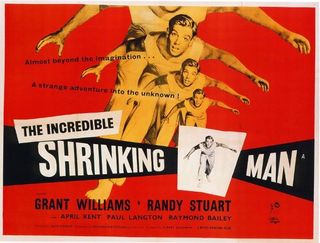
In Keep Watching the Skies , his exhaustive survey of 1950s Sci-Fi cinema, Bill Warren eloquently describes Richard Matheson's two principal works of science fiction - I am Legend (1954) and The Shrinking Man (1956) - as "distilled paranoid nightmares", the former centering around the "core paranoiac fear that everyone in the world is out to get you", the latter hinging on the "equal-but-opposite fear that you don't really matter at all".
A neat summary, and one that hints at some of the key concerns and obsessions that make Matheson’s genre fiction so memorable, unsettling and distinctive. For though it it’s a cliche to interpret all the products of 1950s B-culture as coded expressions of that decade’s rampant paranoia, the “paranoia” on show in Matheson’s work is of a more intimate and idiosyncratic order. This is not populist paranoia sprung from the twin terrors of “reds under the bed” communism or the looming spectre of the mushroom cloud. This is, instead, paranoia of a personal and timeless kind – born of anxieties about alienation, insignificance, worthlessness and repressed sexuality.
Carey’s story, in both book and subsequent Jack Arnold directed film, is a relatively simple one. While on a boating holiday, he becomes exposed to a mysterious radioactive fog: a chance event that, combined with a later accidental exposure to pesticide, begins causing unprecedented height loss. He ultimately finds himself a tiny prisoner in the cellar of his home, battling for survival against a ferocious black widow spider (a battle he eventually wins), before disappearing down into the infinitesimal, the microscopic world.
Sign up to the SFX Newsletter
Get sneak previews, exclusive competitions and details of special events each month!
After the publication of The Shrinking Man , and during a period in which he was suffering considerable financial discomfort, Matheson managed to sell the rights to the novel to Universal-International, with one important proviso attached. Namely, that Matheson himself would be permitted to write the screenplay.
The first draft of the script he submitted to producer Albert Zugsmith (a “man of extremely bad taste”, according to Jack Arnold) followed the novel’s back-and-forth structure. It opened with Carey already miniaturised, imprisoned in the basement, and being pursued by his grotesque eight-legged nemesis. Through a series of staggered flashbacks, the script, like the novel, then detailed precisely how Carey had ended up in this fantastical predicament. Perhaps unsurprisingly, given the movie culture of the time, Zugsmith (who added the adjective “Incredible” to the film’s title) objected to this experimental time-line – handing the script over to writer Richard Allan Simmons who reconfigured it into a linear narrative.
This restructuring left Matheson with a lingering bitterness, and it would be many years before he would have an appreciative word to say about Arnold’s finished product. When SFX asked him, recently, how he now regards the film, after an interval of fifty-plus years, he indicated a considerable thawing of his disapproval: “Usually when a picture first comes out, I’m very unhappy with it. Because it doesn’t follow my scripts to the letter…or at all. Or they’ve heavily rewritten it. In this case, Jack Arnold did such a good job and the young man who played the victim did such a nice job. And it had an ending which was very atypical of endings at that time. So, no - I don’t mind it at all now”.
The “young man” Matheson refers to was Grant Williams: a little-known New York actor whose post- Shrinking Man career was to enter a slow spiral of decline. Despite his later difficulties, Williams proved a perfect Carey: combining a sympathetic everyman-ness with an edgy, frazzled intensity. Though handsome, Williams lacked the swaggering, muscular, square-jawed confidence of an A-list Hollywood leading man – but his tightly-wound vulnerability served the story perfectly. For at its thematic core, this is a film about male anxiety. Carey is literally , after all, a shrinking man. A man who feels “ puny and absurd , a ludicrous midget”. Retaining a “burning...desperate need” for his wife Louise, but feeling utterly emasculated and childlike around her.
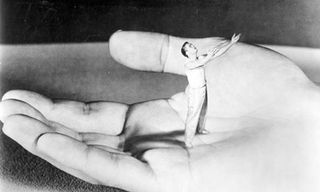
He responds to these feelings of loss - of potency, power and size - by lashing out savagely at her, making her the object of his impotent rage. Given that the theme of male diminishment is writ large (or should that be small?), it’s tempting to read Matheson’s script/novel as expressions of a fear, or even loathing, of female sexuality, coupled with anxiety about the changing nature of male/female roles in late-1950s America. Nascent feminist movements were beginning to assert themselves, the role of the husband as chief breadwinner and household head was being challenged, and the foundations of a previously solid patriarchal structure were beginning to look slightly less sure.
Yet it would be unfair to dismiss Shrinking Man as a reactionary fantasy/nightmare that yearns for a time when male identity was more robust and unthreatened. Firstly, Matheson is careful never to demonise Louise. She is a victim, just as much as he - struggling to keep the family together as the bills mount, the media circus gathers, and their relationship, as man and wife, disintegrates. Grant William’s voice-over in the film clearly casts her as such, while painting Carey as the paranoid, unreasonable aggressor: “Every day it was worse. Every day, a little smaller. And every day I became more tyrannical, more monstrous in my domination of Louise”.
Secondly, Matheson himself has a noted antipathy to “message” or “agenda” led fiction. When pushed on the themes/subtexts of Shrinking Man he’s at pains to stress that he considers, “the whole idea of going out of your way to put a social message in your books”, to be, “kind of foolish”. “None of these things are ever conscious on my part. They emerge from my persona, what I was going through at the time as a human being, and what I was exposed to by society”.
So while gender tensions are undoubtedly present - with Carey unable to function as husband, lover, breadwinner and (in the book) father – the wider anxieties about diminishment are perhaps representative of human - rather than exclusively male - concerns. Matheson himself hints as much: “As I recall my original title was not The Shrinking Man , but Shrinking Man. So I may have had something of that nature in mind. That man’s status was being demeaned and lowered and shrunk. It may have been there subconsciously”.
As in much of Matheson’s genre fiction, characters are at the mercy of arbitrary forces they cannot control. Carey is physically penetrated by the radioactive cloud; prodded, probed and endlessly x-rayed by practitioners of medical science, hounded (and reduced to a freakish figure) by the media, before…er…bring attacked by a giant arachnid. The modern world, Matheson seems to imply, is a cruel, capricious and invasive one. It is all one can do to survive it.
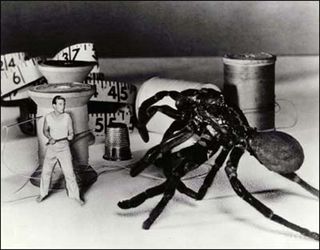
None of this is meant to suggest that The (Incredible)Shrinking Man is merely a Book of Job-like catalogue of suffering and woe. A large part of the appeal of the novel and film is how juicy themes and subtexts are seamlessly married with compelling physical action. One of Matheson’s chief strengths as a writer of genre fiction is his ability to anchor fantastical events by having them play out in very everyday, domestic settings. His fiction continually asks and answers the question, “How would one survive in such extraordinary circumstances?”, by focusing, at length, on environment, details and logistics.
So large sections of the novel, and the entire largely wordless second half of the film, depict Carey climbing, falling, running, collecting and constructing - searching out food, shelter, clothing, ad hoc weaponry etc. We, as readers and viewers, live this laborious struggle with him – feeling his effort and exhaustion and sensing that there is to be no cheaply convenient, deus ex machina resolution of his grim situation.
Perhaps the film’s most celebrated and fondly-remembered sequences are those that focus on this battle for survival. Through a combination of Arnold’s taut direction, Ellis Carter’s shadowy and atmospheric cinematography, Clifford Stine’s mattes and process photography, and some beautifully detailed set and prop design, the cellar is transformed into an utterly convincing and compelling space. Every item in it - from pin cushions, to matchboxes, to old paint tins, mousetraps and spools of thread – becomes a key feature of a strange concrete landscape. “Relics”, Carey imagines, “of a vanished race”.
In an age of ubiquitous greenscreen and CGI - where action sequences often feel gossamer light, unreal and unsubstantial - Williams’ tactile interaction with these physically real, oversized objects never fails to delight. Their dimensions and mass effortlessly sell the illusion of Carey’s tininess and fragility – never more brilliantly than when, after the cellar has flooded, Carey ends up sprawled face-down and unconscious over a giant drain – clutching desperately at a monstrous pencil.
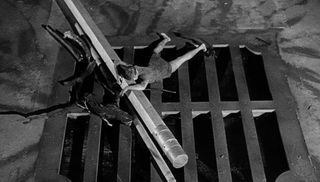
After its hero has undergone such a gruelling and traumatic ordeal one might expect the film’s conclusion to reward him (and us) with a happy ending: an antidote found, the process reversed, a husband and wife reunited. That it doesn’t do so is a testament to Matheson’s commitment to melancholy, and Arnold’s bullish refusal to bow to studio pressure. Much has been made of the ambiguity of Carey’s final speech, as he steps through the bars of the cellar grate (he’s small enough now) and out into the garden and the world beyond. While book and film are alike in the essentials – with Carey realising that even if he shrinks down to a subatomic level, he will still exist (in some brave new world) – the monologue given to Williams in the film as the camera zooms out to reveal brilliant stars and spiralling galaxies is significantly more verbose and metaphysical.
The party responsible for this discrepancy actually appears to be Jack Arnold, who apparently wrote (or rewrote) it to give it a more poetic and quasi-mystical flavour. Whatever the case may be, it’s stirring and thrilling stuff – representing either Carey’s acceptance of his own death, as some have suggested, or his reconciliation with a universe he’d previously detested as brutal and cruel: fading into its subatomic structure and becoming one with it. Or it may mean something entirely different. Or, as harsher critics would have it, nothing at all. Regardless, it remains one of science fiction’s most compelling conclusions:
“I had presumed upon Nature. That existence begins and ends is Man's conception, not Nature's. And I felt my body dwindling, melting, becoming...nothing. My fears melted away. And in their place came...acceptance. All this vast majesty of creation, it had to mean something. And then I meant something, too. Yes, smaller than the smallest, I meant something, too. To God, there is no zero. I still exist!”
RICHARD MATHESON AND THE TWILIGHT ZONE
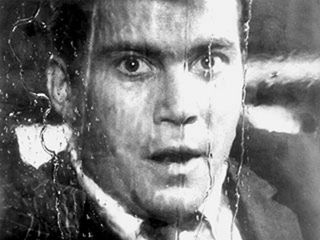
Though Matheson's relationship with most cinematic/televisual adaptations of his work is ambivalent, he retains nothing but fond memories of his close involvement with one of SF's most seminal series: "In The Twilight Zone , except for one actress who fiddled around with the words, no words were ever changed. No plot was ever changed. It was very faithful to my scripts." The finest of his many contributions to the show was "Nightmare At 20,000 Feet", a typically paranoid Matheson tale in which frazzled airplane passenger William Shatner (recovering from a nervous breakdown) is terrorised by a gremlin only he can see.
John Byrne

Nick Setchfield is the Editor-at-Large for SFX Magazine, writing features, reviews, interviews, and more for the monthly issues. However, he is also a freelance journalist and author with Titan Books. His original novels are called The War in the Dark, and The Spider Dance. He's also written a book on James Bond called Mission Statements.
Most Popular


